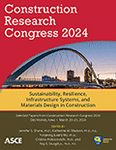Spatial and Demographic Trends in Lead Levels: The Case of Chicago’s Water System
Publication: Construction Research Congress 2024
ABSTRACT
Contaminants, such as lead, in water systems pose significant public health risks. Despite growing public awareness, the presence of lead service lines remains a concern in water systems. Consequently, there is a need to ascertain spatial and demographic trends in lead contamination to identify regional areas to monitor and to inform outreach campaigns. Leveraging lead water quality data collected in Chicago, we use Poisson regression analysis to identify the zip code-level demographic drivers of high lead levels. Our model showed that the percentage of Black residents and the percentage of buildings built before 1980 were significantly associated with the percentage of samples with more than 15 ppb of lead, the EPA standard. Such trends shed light on underlying issues that may contribute to lead contamination, such as historic inequities in the built environment. These findings will assist decision-makers in prioritizing capital projects and educational campaigns, ultimately improving water services.
Get full access to this article
View all available purchase options and get full access to this chapter.
REFERENCES
AWWA. “New EPA Guidance a Reminder: LCRR Requirements around the Corner.” 2023. Accessed May 10, 2023. https://www.awwa.org/AWWA-Articles/new-epa-guidance-a-reminder-lcrr-requirements-around-the-corner.
Akkus, C., and E. Ozdenerol. 2014. “Exploring Childhood Lead Exposure through GIS: A Review of the Recent Literature.” International Journal of Environmental Research and Public Health 2014, Vol. 11, Pages 6314-6334 11 (6): 6314–34. https://doi.org/10.3390/IJERPH110606314.
Batterman, S. A., S. McGinnis, A. E. DeDolph, and E. C. Richter. 2019. “Evaluation of Changes in Lead Levels in Drinking Water Due to Replacement of Water Mains: A Comprehensive Study in Chicago, Illinois.” Environmental Science & Technology 53 (15): 8833–44. https://doi.org/10.1021/acs.est.9b02590.
Brown, M. J., L. A. Spearing, A. Roy, J. A. Kaminsky, and K. M. Faust. 2022. “Drivers of Declining Water Access in Alaska.” Environmental Science & Technology Water 2 (8): 1411–21. https://doi.org/10.1021/acsestwater.2c00167.
Cameron, A. C., and P. K. Trivedi. 2013. Regression Analysis of Count Data. Vol. 53. Cambridge university press.
Dignam, T., R. B. Kaufmann, L. LeStourgeon, and M. J. Brown. 2019. “Control of Lead Sources in the United States, 1970-2017: Public Health Progress and Current Challenges to Eliminating Lead Exposure.” Journal of Public Health Management and Practice : JPHMP 25: S13–22. https://doi.org/10.1097/PHH.0000000000000889.
DWM. “Water Test Kit.” Accessed December 8, 2022. https://www.chicagowaterquality.org/home.
Famoye, F. 2010. “On the bivariate negative binomial regression model.” Journal of Applied Statistics: V. 37, no. 6. 969–981. https://doi.org/10.1080/02664760902984618.
Gazze, L., and J. Heissel. 2021. “Infrastructure Upgrades and Lead Exposure: Do Cities Face Trade-Offs When Replacing Water Mains?” Journal of Environmental Economics and Management 108: 102472. https://doi.org/https://doi.org/10.1016/j.jeem.2021.102472.
Gleason, J. A., J. V. Nanavaty, and J. A. Fagliano. 2019. “Drinking Water Lead and Socioeconomic Factors as Predictors of Blood Lead Levels in New Jersey’s Children between Two Time Periods.” Environmental Research 169 (February): 409–16. https://doi.org/10.1016/J.ENVRES.2018.11.016.
Lawless, J. F. 1987. “Negative Binomial and Mixed Poisson Regression.” Canadian Journal of Statistics 15 (3): 209–25. https://doi.org/10.2307/3314912.
Osman, K. K., and K. M. Faust. 2021. “Toward Operationalizing Equity in Water Infrastructure Services: Developing a Definition of Water Equity.” ACS ES and T Water 1 (8): 1849–58. https://doi.org/10.1021/acsestwater.1c00125.
Osman, K. K., M. E. Hacker, and K. M. Faust. 2023. “Conceptualizing Equity for Onsite Nonpotable Water Reuse Systems in the United States.” Journal of Sustainable Water in the Built Environment 9 (2): 04023002. https://doi.org/10.1061/JSWBAY.SWENG-475.
Oyana, T. J., and F. M. Margai. 2009. “Spatial Patterns and Health Disparities in Pediatric Lead Exposure in Chicago: Characteristics and Profiles of High-Risk Neighborhoods.” 62 (1): 46–65. https://doi.org/10.1080/00330120903375894.
Pieper, K. J., R. Martin, M. Tang, L. Walters, J. Parks, S. Roy, C. Devine, and M. A. Edwards. 2018. “Evaluating Water Lead Levels During the Flint Water Crisis.” Environmental Science & Technology 52 (15): 8124–32. https://doi.org/10.1021/acs.est.8b00791.
Roy, S., and M. A. Edwards. 2019. “Preventing Another Lead (Pb) in Drinking Water Crisis: Lessons from the Washington D.C. and Flint MI Contamination Events.” Current Opinion in Environmental Science & Health 7: 34–44. https://doi.org/https://doi.org/10.1016/j.coesh.2018.10.002.
Schaider, L. A., L. Swetschinski, C. Campbell, and R. A. Rudel. 2019. “Environmental Justice and Drinking Water Quality: Are There Socioeconomic Disparities in Nitrate Levels in U.S. Drinking Water?” Environmental Health: A Global Access Science Source 18 (1): 1–15. https://doi.org/10.1186/s12940-018-0442-6.
Spearing, L. A., F. F. Dias, K. M. Faust, and C. R. Bhat. 2020. “Determining Multilevel Drivers of Perceiving Undesirable Taste and Odor in Tap Water: Joint Modeling Approach.” Journal of Water Resources Planning and Management 147 (3): 04020114. https://doi.org/10.1061/(ASCE)WR.1943-5452.0001326.
Del Toral, M. A., A. Porter, and M. R. Schock. 2013. “Detection and Evaluation of Elevated Lead Release from Service Lines: A Field Study.” Environmental Science & Technology 47 (16): 9300–9307. https://doi.org/10.1021/es4003636.
EPA. “Sources of LEAD in Drinking Water.” 2017. Accessed December 8, 2022. https://www.epa.gov/sites/default/files/2017-08/documents/epa_lead_in_drinking_water_final_8.21.17.pdf.
EPA. Guidance for Developing and Maintaining a Service Line Inventory. August. 2022b.
United States White House. “FACT SHEET: The Biden-Harris Lead Pipe and Paint Action Plan.” 2021. Accessed May 10, 2023. https://www.whitehouse.gov/briefing-room/statements-releases/2021/12/16/fact-sheet-the-biden-harris-lead-pipe-and-paint-action-plan/.
EPA. “Proposed Revisions to the Lead and Copper Rule.” 2021. Accessed May 10, 2023. https://www.epa.gov/ground-water-and-drinking-water/proposed-revisions-lead-and-copper-rule.
EPA. “Revised Lead and Copper Rule.” 2022a. Accessed May 10, 2023. https://www.epa.gov/ground-water-and-drinking-water/revised-lead-and-copper-rule.
White, D., and T. Gala. 2022. “Environmental Injustice? Disparities in the Exposure to Environmental Lead Poisoning and Risks among Children in the Chicago Neighborhoods.” American Journal of Public Health 10 (3): 124–33.
Information & Authors
Information
Published In
History
Published online: Mar 18, 2024
Authors
Metrics & Citations
Metrics
Citations
Download citation
If you have the appropriate software installed, you can download article citation data to the citation manager of your choice. Simply select your manager software from the list below and click Download.
